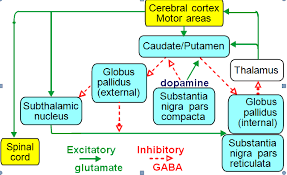What is the exact mechanism that causes Parkinson's disease?
1 Answer
Parkinsonism is characterized by a combination of rigidity, bradykinesia,
tremor, and postural instability that can occur for a
variety of reasons but is usually idiopathic (Parkinson’s disease or
paralysis agitans). Cognitive decline occurs in many patients as the
disease advances. Other nonmotor symptoms—which are receiving
increasing attention—are affective disorders (anxiety or
depression), personality changes, abnormalities of autonomic
function (sphincter or sexual functions; choking; sweating abnormalities;
and disturbances of blood pressure regulation), sleep
disorders, and sensory complaints or pain. The disease is generally
progressive, leading to increasing disability unless effective treatment
is provided.
Pathogenesis

FIG: NORMAL BASAL GANGLIA CIRCUITRY
The pathogenesis of parkinsonism seems to relate to a combination
of impaired degradation of proteins, intracellular protein
accumulation and aggregation, oxidative stress, mitochondrial
damage, inflammatory cascades, and apoptosis. Studies in twins
suggest that genetic factors are important, especially when the
disease occurs in patients under age 50. Recognized genetic abnormalities
account for 10–15% of cases. Mutations of the α-synuclein
gene at 4q21 or duplication and triplication of the normal synuclein
gene are associated with Parkinson’s disease, which is now
widely recognized as a synucleinopathy . Mutations of the leucinerich
repeat kinase 2 ( LRRK2 ) gene at 12cen, and the UCHL1 gene
may also cause autosomal dominant parkinsonism. Mutations in
the parkin gene (6q25.2–q27) cause early-onset, autosomal recessive,
familial parkinsonism, or sporadic juvenile-onset parkinsonism.
Several other genes or chromosomal regions have been
associated with familial forms of the disease. Environmental or
endogenous toxins may also be important in the etiology of the
disease. Epidemiologic studies reveal that cigarette smoking, coffee,
anti-inflammatory drug use, and high serum uric acid levels
are protective, whereas the incidence of the disease is increased in
those working in teaching, health care, or farming, and in those
with lead or manganese exposure or with vitamin D deficiency.
The finding of Lewy bodies (intracellular inclusion bodies
containing α-synuclein) in fetal dopaminergic cells transplanted
into the brain of parkinsonian patients some years previously has
provided some support for suggestions that Parkinson’s disease
may represent a prion disease.
Staining for α-synuclein has revealed that pathology is
more widespread than previously recognized, developing initially
in the olfactory nucleus and lower brainstem (stage 1 of Braak),
then the higher brainstem (stage 2), the substantia nigra (stage 3),
the mesocortex and thalamus (stage 4), and finally the entire neocortex
(stage 5). The motor features of Parkinson’s disease develop
at stage 3 on the Braak scale.
The normally high concentration of dopamine in the basal
ganglia of the brain is reduced in parkinsonism, and pharmacologic
attempts to restore dopaminergic activity with levodopa and
dopamine agonists alleviate many of the motor features of the
disorder. An alternative but complementary approach has been to
restore the normal balance of cholinergic and dopaminergic influences
on the basal ganglia with antimuscarinic drugs. The
pathophysiologic basis for these therapies is that in idiopathic
parkinsonism, dopaminergic neurons in the substantia nigra that
normally inhibit the output of GABAergic cells in the corpus
striatum are lost. Drugs that induce parkinsonian
syndromes either are dopamine receptor antagonists (eg, antipsychotic
agents) or lead to the destruction of the
dopaminergic nigrostriatal neurons (eg, 1-methyl-4-phenyl-1-
,2,3,6-tetrahydropyridine [MPTP]; see below). Various other
neurotransmitters, such as norepinephrine, are also depleted in the
brain in parkinsonism, but these deficiencies are of uncertain
clinical relevance.
SOURCE : Clinical pharmacology: Bertram Katzung Susan Mast

